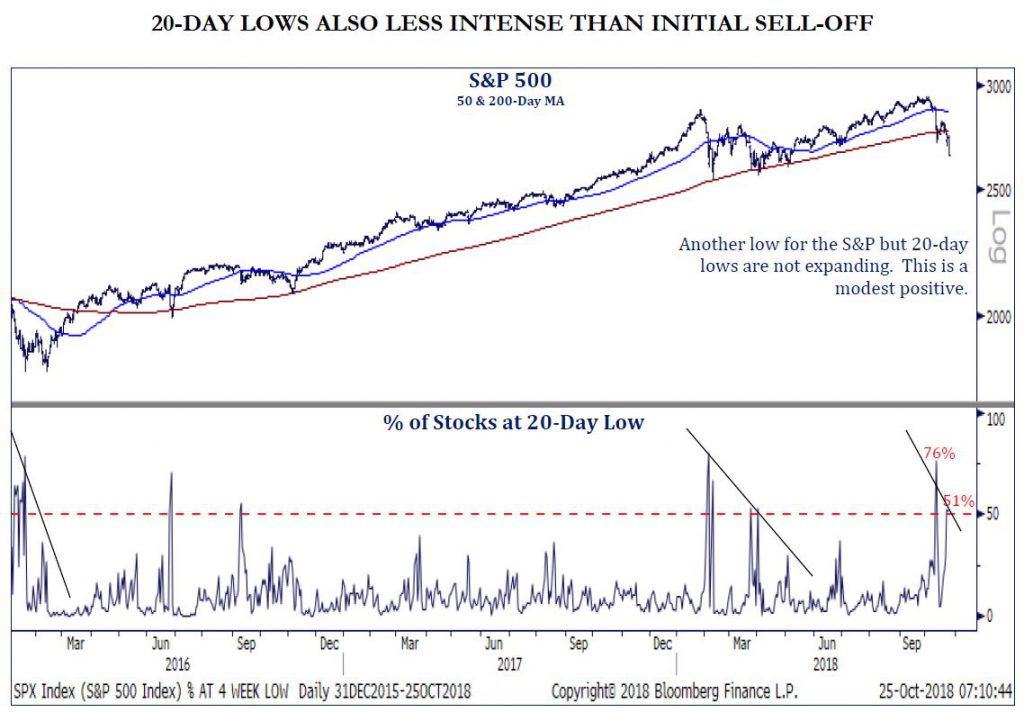We last wrote a “Market Alert” about large stock market movements on August 24, 2015. That fact in itself highlights that it’s been an infrequent occurrence over much of the past two years that investors felt much discomfort. Large market swings or accelerated volatility in stock prices is never a welcome experience – even if we admit they are more common than witnessed throughout much of 2016 or all of 2017. Even long-term investors who are aggressive, maybe opportunistic, and sitting on a lot of cash to invest do not welcome market drawdowns. Yet, market downturns provide opportunity to invest when companies are on sale.
Yesterday (10/24), stocks declined over -3% by the S&P500 index; small company stocks fell more. For October, the up/down market action is causing the month to look “spooky.” Month-to-date, the S&P500 is down almost -9% and the NASDAQ is off almost -12%. A correction is defined as the market declining -10% or more from its recent high. Looking deeper within the market, about 50% of S&P500 stocks established a 20-day low yesterday; that compares to over 75% making a 20-day low 2-weeks earlier on October 10 (or 76% making a 20-day low on February 8 at the earlier correction this year). It is certainly not comforting to know half of the 500 stocks in the S&P index made new 20-day low prices yesterday. BUT, when the number of stocks marking a 20-day low is diminishing from prior selloffs, that is an important statistical event – most corrections do not become bear markets (down over -20%). [See Chart below]. When the number of stocks making fresh 20-day lows is not an expanding number, then the correction process is a matter of 3 things – price, time, and investor emotion (or sentiment). From the low of February 8, the stock market gradually worked its way higher over time, setting a new 2018 high on September 20. Now, unfortunately, the market is re-testing the earlier-year correction low. Frustrating too is how computer algorithm trading of S&P500 futures and ETFs sometimes creates highly emotional volatility in the markets. There is no basis in these activities to underlying fundamentals. Such computer algorithm trading occurs when certain triggers (like 10-year interest rates or other factors) are momentarily “hit”; then computer selling happens instantly.
Ed Yardeni, president & chief market strategist of Yardeni Research, noted “that prior similar declines during this bull market “marked buying opportunities. If this is still a bull market, as we believe it is, then the latest bearish technicals and October swoon should mark the latest buying opportunity.”
Several factors are collectively weighing on the market in October – some earnings disappointments (but many more that are very strong); a brewing conflict between Italy and the EU over budget spending; criticism of oil power Saudi Arabia after the killing of a dissident journalist; worries that world growth is losing steam (as global monetary policy is changing from accommodation); and worry about the US mid-term elections. Noisy news is unsettling to investors, as they struggle to assemble their views about the future.
There will always be gloomy days in the stock market. But also recall, there are many more “sunny” days than “rainy” days, otherwise the historical long-term annualized return of +10% from stocks would not exist. Remember what Warren Buffett once said, “when others are greedy, I am fearful; and when others are fearful, I am greedy.” The stock market is going to advance over time. For long-term investors, selling is never productive to growing wealth – stick with your investment objectives and do not invest on emotions.
Every client portfolio we invest, owns “buckets of time” – meaning each investment portfolio owns exposure to “cash” (money market funds), bonds, and stocks (growth). Recall, that when a “rainy” day occurs, your portfolio owns safe “cash” and bonds to weather the event and provide liquidity if needed. If you are regularly (monthly or quarterly) withdrawing money from your investment account, we can provide $$ without selling growth investments. Please understand that such investment portfolios may own 24 or 36 months, even 7 or 8 years, worth of conservative, safer “cash” and bond investments. That allows any portfolio to weather the “rainy” day of the stock market (the longest recent bear market lasted less than 3 years). Most corrections run less than a year.
In the short–term, we will likely continue to experience market volatility – up/down price movement that may be unsettling. The stock market correction will need to endure the current price decline over time, and modify current investor sentiment. The current correction is technical, but is expected to resume its bull market advance because underlying supportive fundamentals continue.
As this Market Alert title suggests, “this is not your first flat tire.” They are an annoyance and create a time delay. Flat tires often create a sense of frustration, and depending on where it happens, create safety worries. Yet, they are temporary and repairable. So too are market corrections – like a flat tire.
Call or email us with any thoughts or concerns; or to coordinate a time to visit where we can review your investment portfolios and financial goals.
Note: if you would like to dive deeper into our thoughts surrounding recent market volatility, please take a moment to go to the Publications section of our website where we recently posted several additional market-related updates found here: https://nvestwealth.com/news-publications/.
